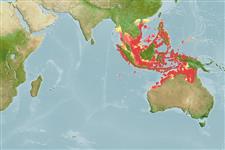Actinopterygii (ray-finned fishes) >
Perciformes (Perch-likes) >
Serranidae (Sea basses: groupers and fairy basslets) > Epinephelinae
Etymology: Epinephelus: Greek, epinephelos = cloudy (Ref. 45335).
Environment / Climate / Range
Ecology
Marine; reef-associated; depth range 10 - 80 m (Ref. 5222). Tropical, preferred ?; 21°N - 21°S, 94°E - 143°E (Ref. 5222)
Western Central Pacific: known only from tropical waters, from Thailand and the Philippines to northern Australia.
Length at first maturity / Size / Weight / Age
Maturity: Lm ?, range 13 - ? cm
Max length : 40.0 cm TL male/unsexed; (Ref. 48635)
Dorsal
spines
(total): 11;
Dorsal
soft rays
(total): 14-16;
Anal
spines: 3;
Anal
soft rays: 8. Preopercle with two to four greatly enlarged serrae at its angle; upper edge of the operculum straight; nostril sub equal. Maxilla reaches to or slightly past the vertical a rear edge of the eye. Pectoral fins not fleshy. Pyloric caeca 7 or 8. Color of head and body pale grayish brown with 5 dark brown bars on the body and 1 on nape. Scattered pale spots may be present on body and some faint small brown spots are often on the edges of the dark bars. The soft dorsal, caudal, and pelvic fins dusky gray, the pectoral fins grayish or orange-red. The jaws and ventral parts of the head sometimes pale reddish brown.
Common on silty sand or mud bottoms. Its preference for soft-bottom habitats may account for its restricted distribution and absence at oceanic islands. Feeds on small fishes and crustaceans (Ref. 89707).
Life cycle and mating behavior
Maturity | Reproduction | Spawning | Eggs | Fecundity | Larvae
Heemstra, P.C. and J.E. Randall, 1993. FAO Species Catalogue. Vol. 16. Groupers of the world (family Serranidae, subfamily Epinephelinae). An annotated and illustrated catalogue of the grouper, rockcod, hind, coral grouper and lyretail species known to date. Rome: FAO. FAO Fish. Synop. 125(16):382 p. (Ref. 5222)
IUCN Red List Status (Ref. 115185)
CITES (Ref. 94142)
Not Evaluated
Threat to humans
Harmless
Human uses
Fisheries: commercial
More information
ReferencesAquacultureAquaculture profileStrainsGeneticsAllele frequenciesHeritabilityDiseasesProcessingMass conversion
Tools
Special reports
Download XML
Internet sources
